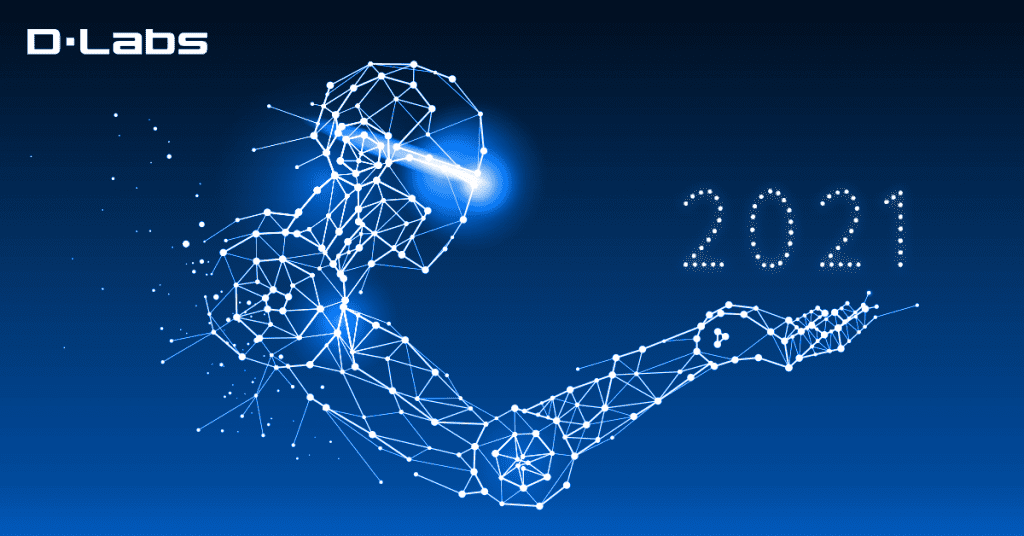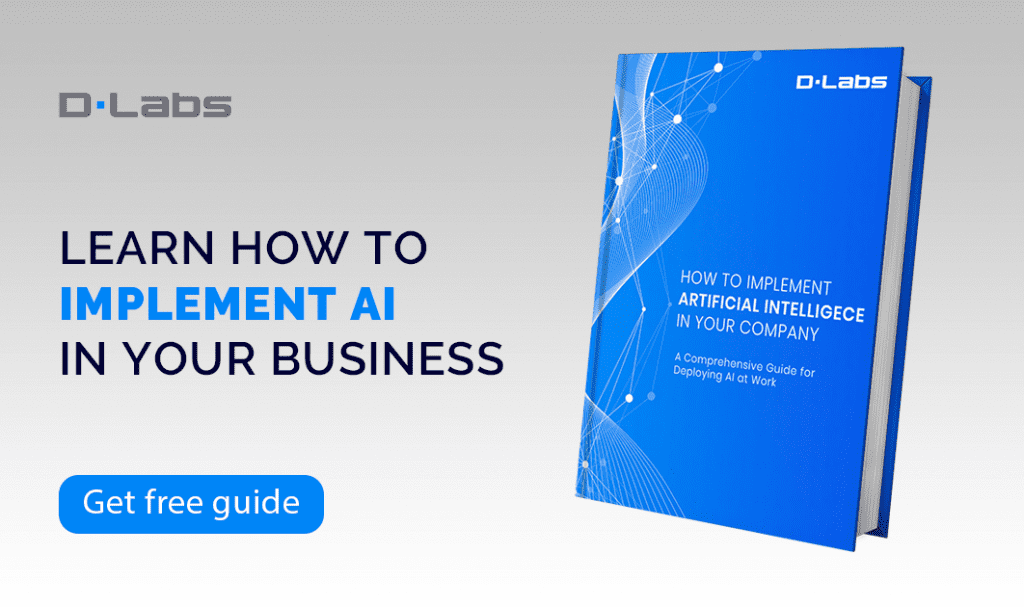Artificial intelligence is developing so quickly that trends can change on a near-weekly basis. What was once a figment of our imagination, the otherworldly dreams we’d read of in science fiction books or see on the screen — is today becoming our reality.
One example is how Microsoft is hoping to reawaken the dead, using chatbots to simulate conversations based on past technology habits (which sounds eerily similar to a disturbing ‘Black Mirror’ episode for any fans out there).
But where else is AI heading? And is the direction… good? There are certainly both bright and “dark sides” of this technological force — and today, I’ll focus on both, highlighting what I see as the most significant AI trends in 2021.

Here we go.
1. ‘AI-based’ Marketing Misleading Consumers
Let’s start with a less optimistic trend.
Nowadays, we’re seeing an increasing number of adverts label products as ‘AI-based’ or ‘smart.’ Unfortunately, many marketers are only using the terms to sell products when, in truth, the goods have little to do with AI.
‘Based on artificial intelligence’ is a strong selling point, after all. But is it worth misleading consumers?
I don’t think so, as the trend will only have negative consequences. People might start confusing AI with more common software, not only causing a misunderstanding of the term. But actually watering down the opportunity as ‘AI’ becomes synonymous with plain ‘technology.’
If you’re unsure what artificial intelligence, machine learning, and big data mean, why not read this article on ‘Everything You Need to Know About Key Differences Between AI, Data Science, Machine Learning and Big Data.’
2. Machines Taking On More Mindless Tasks
One feature of AI that companies, including DLabs.AI, like to point to is how it helps “eliminate human error.”
It’s undoubtedly true; it’s what artificial intelligence is all about. But does that mean computer programs are infallible? Or that we can trust them implicitly? I’d say, not. Because no matter how much AI can help with our daily chores, we might do more harm than good if we trust it too much.
Here are two shining examples:
1. The AI-based Translator
AI can translate brilliantly well. But it’s also a master of nonsense as many words in many languages have several meanings.
In Poland, there’s a popular meme “Thank you from the mountain” — which is the literal translation of “Thank you in advance” as the Polish phrase “z góry” means both “from the mountain” and “in advance.”
2. Applicant Tracking Systems
And here’s a more personal story.
A few years ago, I was looking for an internship in marketing. One of my ‘selling points’ was my knowledge of Adobe Photoshop, so I decided to use it to make a beautiful, stand-out resume. I could see I met most of the job requirements, but I never got a response to my hundreds of applications. Can you guess why?
Well, to make the file as ‘light’ as possible, I compressed it into a ‘flat image,’ flattening the text into the other layers. And as it turned out, my resume never got past the initial tracking system review because the software couldn’t read the text (a fact I later found out from a recruiter who reviews all resumes, even those rejected by the machine).
Am I saying these kinds of tools are bad? Absolutely not.
However, people should realize that the recipe for success is to get machines to work with us. And that’s why I think AI isn’t an existential threat to workplaces, which you can read more about here.
3. RPA 2.0 Streamlining Decision-Making
Okay, let’s flip to a more optimistic note.
When it comes to Robotic Processing Automation (RPA), I’ve no doubt developments will deliver many benefits, especially in business.
According to Grand View Research, the RPA market is currently valued at USD 1.1 billion and is anticipated to see a CAGR of 33.6% from 2020 to 2027. So is it any surprise companies are trying to implement RPA 2.0 into their operations?
Not so much, especially given the benefits include:
- Increased efficiency of core business processes
- Improved customer and employee satisfaction
- Reduced process execution costs
When compared to RPA, RPA 2.0 not only performs repetitive tasks. It takes automation to the next level by actively making complex decisions that only require human verification if absolutely necessary
For more information, including a case study, read this article on “RPA 2.0: How to achieve the highest level of automation?”
4. Improving Risk Detection And Prevention
When given the right data set, artificial intelligence can predict possible risks, allowing authorities to take action to prevent them. This capability has become particularly important during the COVID-19 pandemic.
Remember the case of BlueDot? The company provides software that tracks and anticipates the spread of infectious disease. And it flagged the risk of an epidemic several days before the World Health Organization or Centers for Disease Control and Prevention.
In truth, artificial intelligence can predict everything from accidents to natural disasters to pandemics and more. Which is why scientists worldwide are using it to create advanced predictive models that could ensure a scenario like COVID-19 doesn’t repeat itself.
5. Better Sales Prediction Software
Let’s stay with the predictive powers of AI.
Artificial intelligence not only uses vast data sets to predict and avoid business threats. It can power advanced predictive models to help businesses plan budgets, sales processes, marketing activities, and more.
As a result, entrepreneurs are making smarter decisions than ever, all based on company data — not assumptions. While elsewhere, predictive maintenance is helping manufacturers, among others, minimize the risk of a breakdown, as companies use data to better manage their machinery.
If you want to learn how: check out ‘Predictive Maintenance: This Is How AI Can Transform Industry 4.0.’
6. Enhanced Computer Vision Capabilities
I’ve no doubt computer vision has a role to play this year: be it in banking, manufacturing, healthcare, or marketing. Image and face detection is already used in many ways, in many innovative solutions.
And it will continue to make waves in 2021, appearing in:
- Autonomous vehicles
- Social media filters
- Automated waste segregation
- Documents classification (say, the sorting of paper invoices)
- Translation apps (Google Translate uses ‘optical character recognition’ to overlay an accurate translation)
- Face recognition (iPhones use FaceID and, in China, the police use computer vision at security checkpoints)
- Healthcare (did you know that up to 90% of all medical data users imagery? Computer vision helps doctors analyze mammograms, X-rays, and other images to make earlier diagnoses and even assist with surgery)
If you’re interested in computer vision, check this 45-second YouTube video of how DLabs.AI uses the technology:
7. AI-driven, Self-directed Software Development
Will robots program themselves in the future? Maybe, but it’s unlikely in 2021.
Still, that’s not to say artificial intelligence won’t help software developers code; as I see it, the coming months will see several solutions that can independently detect and fix common IT bugs. And the products won’t only speed up development velocity.
They’ll also help solve developer shortages, with smart IT systems detecting faults and minimizing the time it takes to fix errors. Ultimately, they’ll allow companies to double-down on actual development, delivering solutions to-market faster than ever.
8. The Rise of JavaScript
Until recently, AI programming focused on backend languages, like Python, C++, or Java. However, it seems we’ve hit a turning point. I’m now seeing the rise of JavaScript in machine learning.
Moreover, I’m confident the language will become more popular in 2021 as more developers use it in the machine learning space.
Don’t believe me? Read more about the topic in this article, ‘This Is The Year To Use JavaScript For Machine Learning, Here’s Why.’
9. More Reliance On Synthetic Data
AI has many business benefits, which is why more and more companies are using it. But one struggle remains.
Many organizations don’t have enough data to create robust solutions that meet their expectations. Is there a way to help? Thankfully, yes: it’s called synthetic data. And I expect many more companies to use it in 2021, filling their remaining data gaps.
If you don’t know much about synthetic data, you can read how it works in this article, ‘Why You Don’t Have As Much Data As You Think. And 3 Ways To Fix It.’
10. AI In Reach Of Every Business
Just a few years ago, AI-based solutions were considered complicated and expensive: the reserve of established corporations only
But fast-forward to today… my, how times have changed. Even fledgling startups are implementing solutions to make their work easier, their sales pipeline explode, and their marketing investments deliver higher returns than ever.
The examples are everywhere for all to see:
- Chatbots
- Sales forecasting system
- Invoice generation software
And what are your thoughts on the biggest AI trends in 2021? We’d love to know your opinion — head to Facebook or Linkedin and share a comment.







